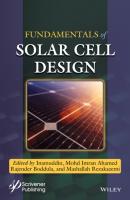Fundamentals of Solar Cell Design. Rajender Boddula
Чтение книги онлайн.

Читать онлайн книгу Fundamentals of Solar Cell Design - Rajender Boddula страница 13
Название: Fundamentals of Solar Cell Design
Автор: Rajender Boddula
Издательство: John Wiley & Sons Limited
Жанр: Физика
isbn: 9781119725046
isbn:
Chapter 7 addresses various computational methodologies from molecular mechanics to quantum mechanics for evaluation of compounds in terms of structural and electronic properties. The main objective is the assessment of photovoltaic parameters including absorption spectra, charge transfer, open-circuit voltage, peak current density, efficiency in light, and molecular descriptors toward the efficient performance of solar cells.
Chapter 8 provides a solar radiation analysis of a region through the use of deterministic models following the specified climatic circumstances. The analysis includes a quantitative analysis for the selection of optimum solar system equipment.
Chapter 9 describes the developments in photovoltaic materials and related devices. Brief description of solar cell generations and the factors that affect efficiency are reviewed. The prospects regarding practices to enhance the conversion efficiencies are shortly presented.
Chapter 10 discusses the efficiencies and materials of conventional, modern, and emerging solar cell technologies. The use of inorganic, organic, and hybrid materials for a rational design of solar cells is discussed in detail. Additionally, the challenges faced by solar cell technologies and performance enhancement techniques are also discussed briefly.
Chapter 11 highlights the latest and emerging characterization tools to study and investigate the properties and efficiency of solar cells. The emerging characterization tools discussed in this chapter are conductive atomic force microscopy, electron tomography, transient absorption spectroscopy, Kelvin probe microscopy, and surface morphology observation.
Chapter 12 briefly describes the historic evolution, fundamental properties, and working principles of photovoltaic cells of various types. The discussion about the efficiency and applications of these solar cells helps the new researchers to develop new technologies and improve their work in the area of solar cell systems.
Chapter 13 gives a detailed overview of the current efforts to enhance the stability of perovskite solar cell; moreover, the degradation causes and mechanisms are summarized. The strategies to improve device stability are portrayed in terms of structural effects, a photoactive layer, holeand electron-transporting layers, electrode materials, and device encapsulation.
Chapter 14 presents the progress of solar cells and their latest developments. The major goal is to show how they can be utilized for photovoltaic energy generation as a renewable energy source. This will help to identify the challenges and drawing prospects for the researchers in this field to further improve and develop solar cells and their applications.
Chapter 15 discusses the design, materials, and applications of semitransparent perovskite solar cells. Different device architectures and the performance evaluation parameters are discussed in detail. The materials used in the photoactive layer, charge transport layers, and transparent electrodes are also presented in addition to the major applications and future scope of semitransparent perovskite solar cells.
Chapter 16 presents an overview of flexible solar cell technology. The various aspects of this technology such as material requirements, and material and cell level characterization techniques and applications are discussed in detail. The chapter is primarily focused on developing an understanding of the current status and future challenges of flexible photovoltaic technology.
Inamuddin
Mohd Imran Ahamed
Rajender Boddula
Mashallah Rezakazemi
June 2021
1
Organic Solar Cells
Yadavalli Venkata Durga Nageswar1* and Vaidya Jayathirtha Rao2
1CSIR - Indian Institute of Chemical Technology, Hyderabad, India
2Hetero Research Foundation, TSIE, Balanagar, Hyderabad, India
Abstract
Limitations faced in using fullerene as an acceptor molecule in BHJOSCs directed research toward non-fullerene–based acceptors in BHJOSCs. Polymer donor and small-molecule acceptor combination is successfully explored to develop higher performance BHJOSCs. Various novel small acceptor organic materials are synthesized and fabricated as sBHJOSCs in combination with suitable polymer donors available. Performances of organic solar cells improved to over 17%, and further, it may cross even 20%. Simultaneously, researchers explored fullerene all small molecules for BHJOSCs. All small-molecule BHJOSCs do not use polymer donor due to certain limitations. Progress achieved from these investigations is remarkable and the efficiency displayed is around 14%. Both the research lines are found to be exceptional and will provide further improvement in the solar cell efficiency. Various examples discussed in this chapter deal with the recent research results reported in the literature on both the research domains.
Keywords: UV-visible absorption, device architecture, film morphology, non-fullerene blends, all small organic molecules, optical band-gap, photovoltaic parameters, photo conversion efficiency
1.1 Introduction
Wind energy is renewable, land around turbine may be used for agriculture, and, further, newer technologies may provide better ways of converting wind energy. There are certain limitations in the wind energy conversion like: unreliable wind source, low production of electricity, higher capital cost, environmental damages, and higher level of noise production. Coal energy is also in practice in some countries and they may be continued, but there are disadvantages like carbon-dioxide production, environmental pollution due to coal burn waste accumulation, and problems associated with coal mining. Fossil fuels are also in practice for generating electricity in some countries, because they are inexpensive, portable, and easily burnt. Limitations to fossil fuels are nonrenewable source, emissions due to burning, and global warming. Geothermal energy is a base load energy source, safer than fossil fuels, and globally sustainable. Disadvantages of this geothermal energy are contamination of unwanted trace elements, localized depletion of energy, and energy imbalance leading to geological instability. Hydrothermal energy for the production of electricity is also in practice in some countries, which has advantages like controlled way of electricity production, ease of water pooling in dams, and utilization of water released after electricity production for irrigation/agriculture. Other disadvantages are higher capital costs, ecological and environmental disturbance, possible wreckage of dams leading to flooding, and hostilities arising due to improper sharing of water. СКАЧАТЬ